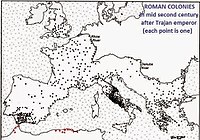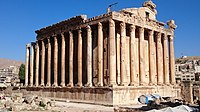| Revision as of 15:15, 24 May 2021 editJalenBarks (talk | contribs)Extended confirmed users, Page movers, Rollbackers103,449 edits Reverted 1 edit by 2601:58C:C080:8AA0:ACF7:7151:927E:1B5B (talk): Rv block evasion: BrunodamTags: Twinkle New redirect Undo Reverted← Previous edit | Revision as of 17:00, 24 May 2021 edit undo2601:58c:c080:8aa0:acf7:7151:927e:1b5b (talk) Hey, folf. who is brudan? why you erase an evident mistake?Tags: Removed redirect Manual revert RevertedNext edit → | ||
| Line 1: | Line 1: | ||
| ] | |||
| #redirect ] | |||
| '''Heliopolis''', fully "Colonia Julia Augusta Felix Heliopolitana" (] for the "Fortunate Julian Augustan Colony in the City of the ]"), was a ] of the ]. It was also known as {{nowrap|'''Heliopolis in Phoenicia'''}} to distinguish it from ] in ]. It was known to locals as ] and it has since regained its historic name. Its ruins are a ]<ref></ref> | |||
| ==History== | |||
| Ancient Baalbek (under its Hellenic name ''Heliopolis'') formed part of the ] kingdoms of ] & ]. It was annexed by the ] during their eastern wars. The ] settlers of the ] "Colonia Julia Augusta Felix Heliopolitana" may have arrived as early as the time of ] but were more probably the ] of two Roman Legions under ], during which time it hosted a Roman garrison. | |||
| ] of Heliopolis]] | |||
| ] ] ornamenting the ]]] | |||
| Indeed the veterans of two ]s were established in the city (and region) of ] by emperor ]: the ] and the ].,<ref></ref> and Heliopolis from 15 BC to 193 AD formed part of the territory of Berytus. The population was mainly local in the second century under ] with a few descendants of the Roman colonists and likely varied seasonally with market fairs and the schedules of the ] to the coast and interior. | |||
| During ], the city's ] to ] & ] was ] first with the worship of the ] ] ]<ref>Cook Arthur </ref> and then with the Greek and ] ] under the name "]" or "]". The present ] presumably replaced an earlier one using the same foundation. The presence of a huge quarry was one of the reasons for the Roman decision to create a huge "Great Court" of a big pagan temple complex in this mountain site, located at nearly 1100 meters of altitude and on the eastern ]: it took three centuries to create this colossal ]'s temple complex, called ''Sanctuary'' of Heliopolis.<ref>Video-Panoramas of the Sanctuary temples at </ref> | |||
| ==Monoliths== | |||
| Heliopolis contains some of the biggest monoliths of ], inccuding the ] and the ]: | |||
| {| class="wikitable sortable" style="margin:1px; border:1px solid #cccccc; " | |||
| |----- align="left" valign="top" bgcolor="cccccc" | |||
| ! width="10%" | Date | |||
| ! width="20%" | Building / Object | |||
| ! width="20%" | Monolith | |||
| ! width="10%" | Weight <br />(in ]) | |||
| ! width="20%" | Comment | |||
| |- | |||
| | {{Sort|100|1st–2nd c.}} | |||
| | ] <ref>{{harvnb|Ruprechtsberger|1999|p=15}}</ref> | |||
| | Block in quarry | |||
| | {{Sort|100000.12|{{0|~}}1000.12}} | |||
| | | |||
| |- | |||
| | {{Sort|100|?}} | |||
| | ] <ref>{{harvnb|Ruprechtsberger|1999|p=17}}</ref> | |||
| | Block in quarry | |||
| | {{Sort|124200|{{0|~}}1242}} | |||
| | | |||
| |- | |||
| | {{Sort|100|?}} | |||
| | ] | |||
| | Block in quarry | |||
| | {{Sort|124200|{{0|~}}1650}} | |||
| | Biggest monolith in the world | |||
| |- | |||
| | {{Sort|100|1st–2nd c.}} | |||
| | Layer beneath ] <ref name="Adam 1977, 52"/>/ | |||
| | Blocks, several | |||
| | {{Sort|035000|{{0|~}}]350}} | |||
| | Podium of Jupiter temple | |||
| |- | |||
| | {{Sort|100|1st–2nd c.}} | |||
| | ] <ref name="Adam 1977, 52">{{cite journal|last = Adam | |||
| | first = Jean-Pierre | |||
| | title = À propos du trilithon de Baalbek: Le transport et la mise en oeuvre des mégalithes | |||
| | journal = Syria | |||
| | volume = 54 | |||
| | issue = 1/2 | |||
| | year = 1977 | |||
| | pages = 31–63 | |||
| | url = http://www.persee.fr/web/revues/home/prescript/article/syria_0039-7946_1977_num_54_1_6623 | |||
| | language = French | |||
| | doi=10.3406/syria.1977.6623 | |||
| }}</ref> | |||
| | Blocks, three | |||
| | {{Sort|080000|{{0|~}}]800}} | |||
| | Podium of Jupiter temple | |||
| |- | |||
| | {{Sort|100|1st–2nd c.}} | |||
| | ] | |||
| | ], lower | |||
| | {{Sort|004850|{{0|~11}}48.5}} | |||
| | | |||
| |- | |||
| | {{Sort|100|1st–2nd c.}} | |||
| | ] | |||
| | ]-], central | |||
| | {{Sort|006300|{{0|~11}}63}} | |||
| | Lifted by ] to height of 19 m<ref name="Coulton 1974, 16, 19">{{cite journal|last=Coulton |first=J.J. |title=Lifting in Early Greek Architecture |journal=Journal of Hellenic Studies |volume=Vol. 94 |date=1974 }}</ref> | |||
| |- | |||
| | {{Sort|100|1st–2nd c.}} | |||
| | ] | |||
| | ], corner | |||
| | {{Sort|010800|{{0|~1}}108}} | |||
| | Lifted by ] to height of 19 m<ref name="Coulton 1974, 16, 19"/> | |||
| |- | |||
| |} | |||
| ])]] | |||
| ] | |||
| ==References== | |||
| <references/> | |||
| ==Bibliography== | |||
| * Alouf, Michael. ''History of Baalbek'' Publisher American Press. Beirut, 1998 () | |||
| * {{citation |last=Cook |first=Arthur Bernard |title=Zeus: A Study in Ancient Religion |url=http://digi.ub.uni-heidelberg.de/diglit/cook1914bd1/0011 |volume= |location=] |publisher=Cambridge University Press |date=1914 }}. | |||
| * Lohmann, Daniel (2010). ''Giant Strides towards Monumentality: The architecture of the Jupiter Sanctuary in Baalbek/Heliopolis''. Bolletino di Archeologia , Special Volume, pp. 29–30. | |||
| ==See also== | |||
| {{Portal|Ancient Rome|Lebanon}} | |||
| * ] | |||
| * ] | |||
| * ] | |||
| * ] | |||
| * ] | |||
| {{Roman colonies in ancient Levant}} | |||
| {{Archaeological sites in Lebanon}} | |||
| {{Roman Archaeological sites in Beirut & Lebanon}} | |||
| ] | |||
Revision as of 17:00, 24 May 2021

Heliopolis, fully "Colonia Julia Augusta Felix Heliopolitana" (Latin for the "Fortunate Julian Augustan Colony in the City of the Sun"), was a colony of the Roman Empire. It was also known as Heliopolis in Phoenicia to distinguish it from Heliopolis in Egypt. It was known to locals as Baalbek and it has since regained its historic name. Its ruins are a Unesco world heritage site
History
Ancient Baalbek (under its Hellenic name Heliopolis) formed part of the Diadochi kingdoms of Egypt & Syria. It was annexed by the Romans during their eastern wars. The Italic settlers of the Roman colony "Colonia Julia Augusta Felix Heliopolitana" may have arrived as early as the time of Caesar but were more probably the veterans of two Roman Legions under Augustus, during which time it hosted a Roman garrison.


Indeed the veterans of two Roman legions were established in the city (and region) of Berytus by emperor Augustus: the fifth Macedonian and the third Gallic., and Heliopolis from 15 BC to 193 AD formed part of the territory of Berytus. The population was mainly local in the second century under Hadrian with a few descendants of the Roman colonists and likely varied seasonally with market fairs and the schedules of the caravans to the coast and interior.
During Classical Antiquity, the city's temple to Baʿal & Haddu was conflated first with the worship of the Greek sun god Helios and then with the Greek and Roman sky god under the name "Heliopolitan Zeus" or "Jupiter". The present Temple of Jupiter presumably replaced an earlier one using the same foundation. The presence of a huge quarry was one of the reasons for the Roman decision to create a huge "Great Court" of a big pagan temple complex in this mountain site, located at nearly 1100 meters of altitude and on the eastern Borders of the Roman Empire: it took three centuries to create this colossal Roman paganism's temple complex, called Sanctuary of Heliopolis.
Monoliths
Heliopolis contains some of the biggest monoliths of Classical Antiquity, inccuding the Baalbek Trilithon and the Stone of the Pregnant Woman:
| Date | Building / Object | Monolith | Weight (in t) |
Comment |
|---|---|---|---|---|
| 1st–2nd c. | Stone of the Pregnant Woman | Block in quarry | ~1000.12 | |
| ? | Unnamed monolith | Block in quarry | ~1242 | |
| ? | Unnamed monolith | Block in quarry | ~1650 | Biggest monolith in the world |
| 1st–2nd c. | Layer beneath Trilithon / | Blocks, several | ~∅350 | Podium of Jupiter temple |
| 1st–2nd c. | Trilithon | Blocks, three | ~∅800 | Podium of Jupiter temple |
| 1st–2nd c. | Temple of Jupiter | Column drum, lower | ~1148.5 | |
| 1st–2nd c. | Temple of Jupiter | Architrave-frieze block, central | ~1163 | Lifted by cranes to height of 19 m |
| 1st–2nd c. | Temple of Jupiter | Cornice block, corner | ~1108 | Lifted by cranes to height of 19 m |


References
- UNESCO: Heliopolis/Baalbeck
- Roman Berytus: a colony of legionaries
- Cook Arthur 550
- Video-Panoramas of the Sanctuary temples at Discover Lebanon: Heliopolis temples
- Ruprechtsberger 1999, p. 15 harvnb error: no target: CITEREFRuprechtsberger1999 (help)
- Ruprechtsberger 1999, p. 17 harvnb error: no target: CITEREFRuprechtsberger1999 (help)
- ^ Adam, Jean-Pierre (1977). "À propos du trilithon de Baalbek: Le transport et la mise en oeuvre des mégalithes". Syria (in French). 54 (1/2): 31–63. doi:10.3406/syria.1977.6623.
- ^ Coulton, J.J. (1974). "Lifting in Early Greek Architecture". Journal of Hellenic Studies. Vol. 94.
{{cite journal}}:|volume=has extra text (help)
Bibliography
- Alouf, Michael. History of Baalbek Publisher American Press. Beirut, 1998 ()
- Cook, Arthur Bernard (1914), Zeus: A Study in Ancient Religion, vol. Vol. I: Zeus God of the Bright Sky, Cambridge: Cambridge University Press
{{citation}}: External link in|volume= - Lohmann, Daniel (2010). Giant Strides towards Monumentality: The architecture of the Jupiter Sanctuary in Baalbek/Heliopolis. Bolletino di Archeologia , Special Volume, pp. 29–30.
See also
| Colonies of ancient Rome | ||||||||||||||||||||
|---|---|---|---|---|---|---|---|---|---|---|---|---|---|---|---|---|---|---|---|---|
| With correspondence to modern geography | ||||||||||||||||||||
| Europe |
|   | ||||||||||||||||||
| Levant |
| |||||||||||||||||||
| ||||||||||||||||||||
